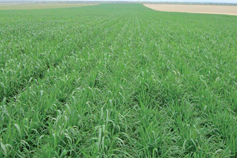Shaping The Future of Farming
 Last year I managed to follow the Future of Farming Dialog 2017, an annual event hosted by the Crop Science division of Bayer, which brings together approximately 250 opinion leaders, stakeholders and media in an open forum to discuss the important issues facing food and agriculture today and in the future. I believe last year’s conference set the right tone to address one of the most important questions of our time: How to feed a growing population in an environmentally sustainable way?
Last year I managed to follow the Future of Farming Dialog 2017, an annual event hosted by the Crop Science division of Bayer, which brings together approximately 250 opinion leaders, stakeholders and media in an open forum to discuss the important issues facing food and agriculture today and in the future. I believe last year’s conference set the right tone to address one of the most important questions of our time: How to feed a growing population in an environmentally sustainable way?
When it comes to the energy that sustains us, we’re up against significant challenges to ensure an adequate supply of safe, nutritious and affordable food now and in future. By 2050, we will need to feed an additional three billion people, requiring an increase in food production by 50%. This significant growth in demand, coupled with ongoing environmental degradation, a lack of arable land and a changing climate, means that more – not less – science and innovation is needed to meet the needs of the future. But producing more food is only half the battle. We also must be able to produce food more sustainable, so that we can preserve our limited natural resources for generations to come.
 I believe breakthrough, sustainable innovation will only increase as agriculture brings together new developments in biological, chemical and data sciences. Advances in these areas will over time revolutionize farming and lead to more customized solutions for growers large and small so that, ultimately, they can produce more food with less resources.
I believe breakthrough, sustainable innovation will only increase as agriculture brings together new developments in biological, chemical and data sciences. Advances in these areas will over time revolutionize farming and lead to more customized solutions for growers large and small so that, ultimately, they can produce more food with less resources.
It’s here that innovators can make a significant contribution to feeding the growing world population in a sustainable manner – but they can’t do it alone. This immense challenge will take a collective effort with others in their field. All have an important role to play in ensuring that tomorrow’s innovations are safe and sustainable. With a long-held commitment to research and development, researchers have an enviable innovation pipeline, but they recognize that there are outstanding technologies also beyond their doors. There is need therefore intensify external partnerships and collaborations and pursuing open innovation to help accelerate new discoveries. But even the greatest innovation in the world cannot be successful without societal acceptance.
One of the main objectives of the Future of Farming Dialog was to bring different voices to the conversation. When it comes to learning, there’s simply no substitute for dialog. As they discussed during the event, we are living in a post-truth era in which populism and political polarization endanger rational conversations about modern science and jeopardize the acceptance of scientific breakthroughs that are needed to ensure enough healthy food for a growing population.
Ensuring the availability of safe, affordable and nutritious food for everyone is something nearly everyone agrees on, but when we talk about how we can best achieve that goal the consensus quickly evaporates. Consumers are often concerned about the safety of today’s innovations while acknowledging their role in meeting the needs of the future.
How to feed a growing population in an environmentally sustainable way must take a collective effort.
How can we bridge the gap between the general desire to improve the sustainability of the food supply on the one hand, and the partial lack of public acceptance for the use of certain innovations and technologies to holistically address this issue on the other hand?
There is no quick fix to the challenges facing farming and the public’s view of agricultural technology, but I believe a multi-stakeholder approach is required to better engage consumers through active listening, open dialog and better education around the benefits of innovation—not just the benefits for farmers, but also the benefits for consumers and the environment. We need to encourage a political and regulatory system that focuses on true sustainability with a risk-benefit approach. In addition we should aim to foster collaboration across the food chain and make sure that the dots can be connected for both growers and consumers. In essence, we need to engage much more with all key stakeholders to learn about and address their needs, motivations and concerns, including suppliers, producers, governments, NGOs, and investors.
The conference brought together leaders, stakeholders and media because in a world where emotions sometimes drown out facts, there is need to ensure the public truly understands the benefits of science and innovation.
Agriculture is constantly evolving – and that’s an opportunity for anybody who wants to positively shape the future of farming. We must be responsive to the changing world around us to help ensure a more sustainable, more resource-efficient tomorrow. We must do everything we can to help ensure new technologies and farming practices will meet the needs of both growers and consumers and help preserve the environment that we all share together. The challenges the world faces today can be solved through science and innovation, but in a world where emotions sometimes drown out facts, we need to ensure the public truly understands the value of what we do.
I believe last year’s conference set the right tone to show how serious it is to foster societal dialogue around the benefits of science and innovation. Events like this will help ensure that the great work of our scientists can have maximum impact by not only helping growers solve their problems, but also by helping the public understand why what we do is so important.